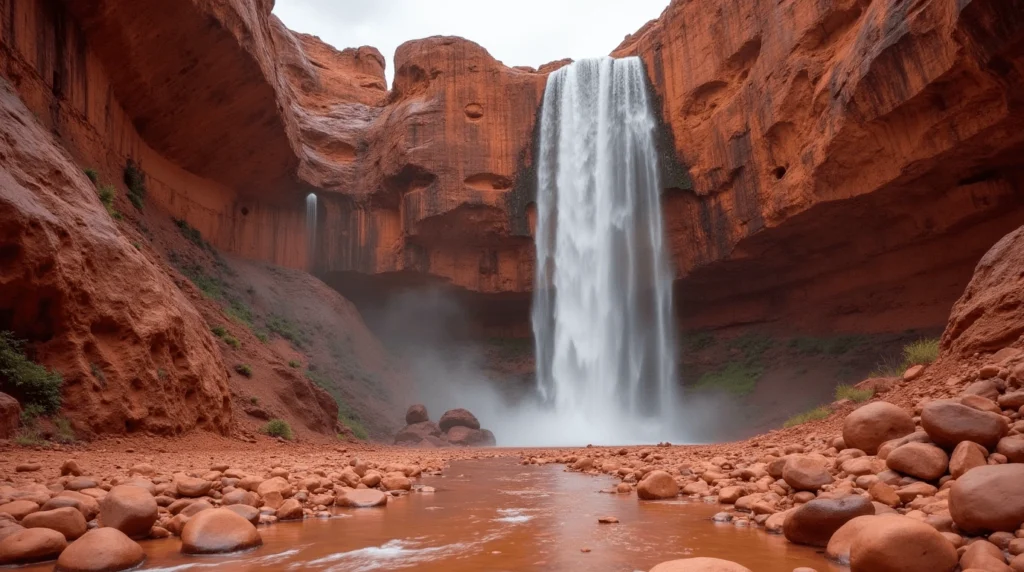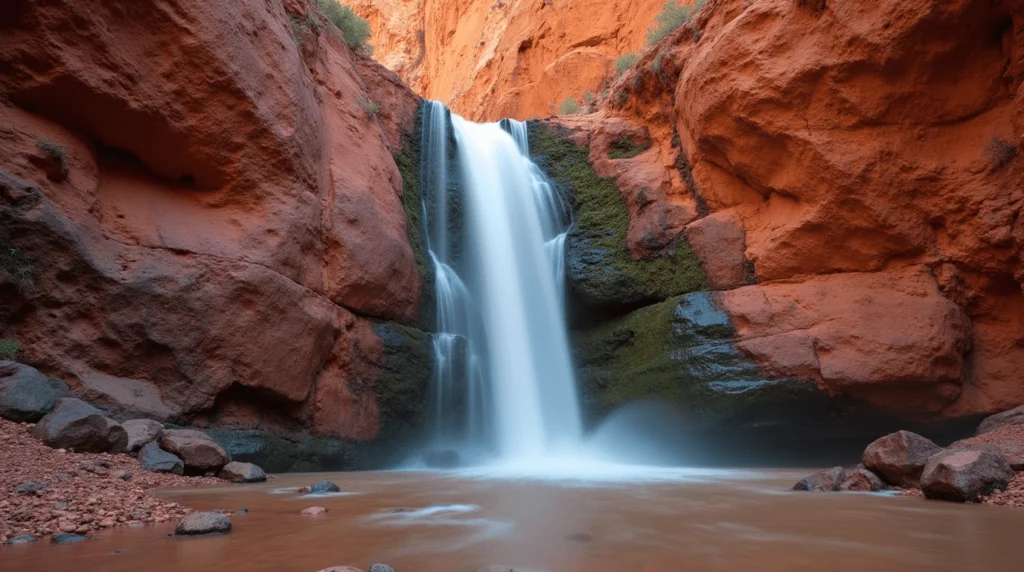Introduction: Nature’s Colorful Surprise on Waimea Canyon Drive
Kauai’s Red Dirt Waterfall is a small, unique roadside cascade on Waimea Canyon Drive (Highway 550), famous for flowing over vibrant iron-rich red soil. Its visibility is highly dependent on recent rainfall. Learn more about Kauai’s weather patterns and rainfall at the National Weather
Imagine driving up Waimea Canyon Road when a flash of crimson catches your eye – water trickling over what looks like liquid rust, creating a startling contrast against the surrounding greenery. This is Kauai’s famous red dirt waterfall, one of the island’s most photographed roadside attractions despite its modest size. Unlike Hawaii’s towering tropical cascades, this small but captivating red waterfall offers something completely different: a vivid demonstration of Kauai’s unique geology where water and volcanic soil create a natural artwork.
In this comprehensive guide, we’ll cover everything you need to know about this distinctive Waimea Canyon red waterfall: its exact location, the fascinating geology behind its vibrant color, the best times to visit, photography tips to capture its beauty, and how to incorporate this quick stop into your broader Kauai adventure. Whether you’re a photographer, geology enthusiast, or simply a curious traveler seeking Kauai’s hidden gems, this roadside waterfall in Kauai deserves a spot on your itinerary.
Table of Contents
Quick Facts: Red Dirt Waterfall at a Glance
| Feature | Detail |
|---|---|
| Location | Waimea Canyon Drive (Hwy 550), Kauai, HI |
| Approx. Mile Marker | Mile Marker 4-5 |
| GPS Coordinates | 21.9713° N, 159.6742° W |
| Type | Roadside Cascade / Runoff Channel |
| Height | Variable, typically 3-10 feet depending on rainfall |
| Best Time to See | After significant rainfall |
| Parking | Small roadside pull-off (limited for 2-3 vehicles) |
| Cost | Free |
| Time Needed | 5-15 minutes (quick photo stop) |
| Accessibility | Viewable directly from the road/pull-off |
Understanding Kauai’s Red Dirt Waterfall Phenomenon

What Exactly Is It?
The red dirt waterfall isn’t a traditional waterfall in the sense of a river plunging over a cliff. Rather, it’s primarily a drainage feature where rainwater collects and flows down the mountainside, concentrated by the roadside construction of Waimea Canyon Drive. During and after heavy rainfall, water gathers on the slopes above the road, creating temporary channels as it descends through Kauai’s famous red dirt before crossing under the road through culverts.
What makes this particular drainage spot special is how it showcases the island’s distinctive red soil in dynamic form. When flowing with sufficient water, the contrast between the clear water and crimson earth creates an almost surreal visual effect – as though the earth itself is bleeding onto the roadside.
The Science of Red: Kauai’s Volcanic Legacy
The star of this geological show is undoubtedly Kauai’s famous red dirt. But what creates this vivid coloration? The answer lies in the island’s volcanic origins and subsequent weathering processes:
- Volcanic Foundation: As the oldest of Hawaii’s main islands (approximately 5 million years), Kauai’s landscape has had more time to weather and develop its distinctive soil profile.
- Iron-Rich Basalt: The original volcanic basalt that formed Kauai contained high concentrations of iron and other minerals.
- Oxidation Process: Over millions of years, exposure to oxygen and rainwater caused the iron in the soil to oxidize – essentially rust – turning the soil its characteristic red color.
- Clay Development: Continued weathering transformed many minerals into clay particles, creating soil that becomes slippery and easily transportable when wet.
- Minimal Organic Material: The intense weathering and leaching in tropical conditions removed many nutrients, resulting in soil with relatively low organic content, which allows the mineral coloration to dominate.
This combination of factors created the perfect conditions for Kauai’s striking red dirt landscape. When water flows over this soil, it often carries fine particles with it, creating the red-tinted water that makes the waterfall so photogenic.
Logistics & Planning: Finding the Red Dirt Waterfall
Precise Location & How to Find It
Finding the red dirt waterfall requires some attention as you drive along Waimea Canyon Drive, as it’s easy to miss if you’re not looking for it. View an official Hawaii road map to navigate the area better at the Hawaii Department of Transportation.
From Waimea Town:
- Head north on Highway 550 (Waimea Canyon Drive)
- Continue approximately 4-5 miles up the winding road
- Watch for a notable red dirt bank on your left side
- Look for a small pull-off area where other cars might be stopped for photos
From Kokee State Park:
- Drive south on Highway 550
- Continue approximately 11-12 miles down from the Kokee Museum
- Watch for the red dirt formations on your right
- The waterfall will be visible shortly before reaching the Waimea Canyon Lookout when coming from this direction
Local Tip: The red color of the soil becomes even more vibrant just after rain but before the sun has dried everything, making colors pop dramatically against the green vegetation.
<div class=”map-container”> [Interactive Google Map would be embedded here] </div>
Parking & Viewing Safely
Parking at the red dirt waterfall requires some caution:
- The pull-off area is small and can accommodate only 2-3 vehicles
- There are no formal parking spaces or barriers from the road
- The shoulder may be soft, especially after rain
- Traffic on Highway 550 can move quickly around the curves
For your safety:
- Signal early and slow down gradually before pulling over
- Ensure your vehicle is completely off the roadway
- Watch for approaching vehicles before exiting your car
- Keep children close and supervised near the road
- Don’t climb on the fragile red dirt banks, which can collapse easily
- Stay on established viewing areas to prevent erosion and for your safety
When to Visit for the Best Experience

Rainfall Dependency
The red dirt waterfall’s flow is entirely dependent on recent rainfall, making timing your visit somewhat unpredictable. Check real-time Kauai rainfall data and forecasts at the USGS Hawaii Water Science Center. Here’s what to expect:
After Heavy Rain:
- Maximum water flow
- Most vibrant color contrast
- Best photographic opportunity
- Potential for muddy viewing conditions
During Dry Periods:
- Minimal to no water flow
- Still interesting for the red dirt formations
- Clearer viewing areas
- Less dramatic visual impact
Seasonal Considerations
- Winter (Nov-Apr): Generally Kauai’s rainy season, offering the highest chance of seeing the waterfall flowing well
- Summer (May-Oct): Typically drier, with less reliable water flow but more predictable viewing conditions
Time of Day
For photography, consider these timing options:
- Morning: Soft light, fewer visitors, good if the waterfall is on the western side of the road
- Midday: Harsh light but maximum visibility of colors
- Late Afternoon: Warmer light tones can enhance the red colors, but may cast shadows depending on the orientation
Capturing the Red Dirt Waterfall: Photography Tips
Camera Settings for Vibrant Results
To truly capture the dramatic contrast of the red dirt waterfall: Learn how to use polarizing filters and camera settings effectively with the National Park Service’s guide to landscape photography.
- Polarizing Filter: Perhaps the most valuable accessory for this location, a polarizing filter will reduce glare on wet surfaces and dramatically enhance the saturation of the red earth and green vegetation.
- Exposure Settings:
- Slightly underexpose (by about -0.3 to -0.7) to preserve the rich red tones
- For flowing water: Use a slower shutter speed (1/15 to 1/4 second) to capture silky water movement
- For texture detail: Use a faster shutter speed (1/125 or faster) to freeze water droplets and maintain soil texture
- White Balance: Set to “Cloudy” or “Shade” even on sunny days to enhance the warmth of the red tones
Composition Ideas
Consider these framing options for more compelling photos:
- Context Shots: Include the road and surrounding landscape to show the unique roadside nature of this feature
- Close-ups: Focus on where the water first contacts the red soil, capturing the contrast
- Texture Studies: Zoom in on the patterns formed by water flowing over the red earth
- Color Contrast: Frame the red against the green vegetation for maximum impact
- People for Scale: Include a person (from a safe distance) to demonstrate the waterfall’s size
Smartphone Photography Tips
Don’t have a professional camera? Your smartphone can still capture spectacular images:
- Use HDR mode to balance the bright sky with shadowed areas
- Tap on the red dirt to set exposure correctly
- Use portrait mode for dramatic close-ups with background blur
- Try panorama mode to capture the entire roadside context
- Consider using editing apps to enhance vibrance and contrast after shooting
Managing Expectations: Is the Red Dirt Waterfall Worth Visiting?
Let’s be honest – the red dirt waterfall isn’t Kauai’s most dramatic natural attraction. Understanding what to expect helps ensure you’ll appreciate this unique feature:
Who Will Most Appreciate It:
- Photographers: The unique colors and textures offer distinctive visual opportunities
- Geology Enthusiasts: It’s a perfect demonstration of Kauai’s volcanic soil properties
- Efficiency-Minded Travelers: As a quick roadside stop, it requires minimal time investment
- Thorough Explorers: Those who enjoy experiencing all aspects of a destination, not just the highlights
When It Might Disappoint:
- If visited during prolonged dry periods when there’s no water flow
- If expecting a large, traditional waterfall
- If the pull-off area is crowded, making photography difficult
Visitor Perspective: “We almost drove past thinking it was just some muddy runoff, but I’m so glad we stopped! The vibrant red against the green jungle backdrop made for some of our most unique Hawaii photos. Just a 10-minute stop but totally worth it!” – Sarah T., California
Integrating the Red Dirt Waterfall into Your Waimea Canyon Itinerary
The red dirt waterfall makes the most sense as one stop on your journey up or down Waimea Canyon Drive. Here’s how to incorporate it efficiently:
Suggested Itinerary Order (Starting from Waimea Town):
- Begin Early: Start your drive up from Waimea town before 9 AM to beat crowds
- Red Dirt Waterfall: Make this your first quick stop (~Mile Marker 4-5)
- Waimea Canyon Lookout: Continue to the main lookout for classic canyon views
- Pu’u Hinahina Lookout: For another perspective of the canyon
- Koke’e State Park Museum: Learn about the area’s ecology and history
- Kalalau Lookout: Experience breathtaking views of the Nāpali Coast
- Pu’u O Kila Lookout: The end of the road with more Nāpali views
- Return Trip: Stop at any lookouts you missed on the way up
Nearby Alternatives If Conditions Are Dry:

If the red dirt waterfall isn’t flowing during your visit, consider these nearby attractions:
- Waimea Canyon Artisan Market: Often set up near the canyon entrance on weekends
- Iliau Nature Loop: A short, easy trail showcasing native plants
- Cliff Trail Viewpoint: Less visited but offers spectacular canyon views
- Kukui Trail: For more adventurous hikers wanting to descend into the canyon
Frequently Asked Questions About the Red Dirt Waterfall
Is the Red Dirt Waterfall always flowing?
No, the flow is entirely dependent on recent rainfall. Get historical precipitation trends for Kauai from the NOAA Climate Data Center , During dry periods, especially in summer, there may be little to no water visible. However, the red dirt formations themselves remain interesting even when dry.
Can you swim in the Red Dirt Waterfall?
Absolutely not. This is a roadside drainage area that is neither safe nor suitable for swimming. The water quality is unpredictable, the area is directly adjacent to a highway, and the soil is extremely erosive.
Is the Red Dirt Waterfall natural or man-made?
It’s a combination of both. The red soil and water runoff are completely natural, but the concentration of water flow in this specific location is influenced by the road construction and drainage design of Highway 550.
How long should I spend at the Red Dirt Waterfall?
Most visitors spend between 5-15 minutes photographing and observing the waterfall. As a roadside attraction with limited space, it’s best enjoyed as a quick stop rather than an extended destination.
Why is the dirt so red in this part of Kauai?
As explained in our geology section, the vibrant red color comes from the high iron content in Kauai’s volcanic soil that has oxidized (rusted) over millions of years of exposure to air and rainwater.
Is there a fee to see the Red Dirt Waterfall?
No, this is a free roadside attraction with no entrance or parking fees. However, the limited parking means you may need to circle back if the pull-off area is full when you arrive.
Will the red dirt stain my clothes or shoes?
Yes! Kauai’s red dirt is notoriously difficult to remove from fabric. If you plan to get close to the waterfall or walk on the red soil, wear dark clothing or items you don’t mind potentially staining permanently.
Are there facilities like restrooms nearby?
No, there are no facilities at the waterfall site. The nearest public restrooms are at the main Waimea Canyon Lookout or at businesses in Waimea town.
Conclusion: A Brief But Memorable Kauai Experience
The red dirt waterfall of Waimea Canyon exemplifies what makes Kauai so special – the unexpected natural wonders that appear around nearly every bend in the road. While not the tallest or most powerful waterfall on the island, its unique coloration creates a visual experience you won’t find anywhere else in Hawaii.
As you plan your journey through Waimea Canyon, remember that this quick roadside stop offers something distinctly “Kauai” – a perfect demonstration of the Garden Isle’s volcanic heritage in one of its most vibrant forms. The red dirt waterfall reminds us that sometimes nature’s most interesting displays come in smaller packages, requiring just a moment of attention to appreciate their unique beauty.
Have you visited the red dirt waterfall on your Kauai adventure? We’d love to hear about your experience in the comments below! And don’t miss our complete guide to Waimea Canyon for more insider tips on experiencing “The Grand Canyon of the Pacific.”


